Business Proposal: Mobile App Fraud Detection and Prevention
VerifiedAdded on 2022/11/23
|6
|1649
|87
Project
AI Summary
This business proposal addresses the problem of mobile app fraud, specifically for Queens Rideshare, a ride-sharing company. The proposal outlines a five-step approach to detect and prevent attribution fraud, ultimately lowering user acquisition costs. The techniques proposed include significant data cleaning to remove inaccurate and irrelevant data; significant data exploration to identify patterns and key features; regression analysis to identify trends and relationships between variables; predictive modeling and hypothesis testing to predict outcomes and develop a "Quality Score" card for fraud likelihood; and the use of an executive dashboard to visualize key metrics and KPIs. Each technique is described in terms of its appropriateness, potential limitations, and mitigation strategies. The proposal emphasizes how these techniques will enable Queens Rideshare to identify and eliminate fraudulent activities, optimize data, and make informed decisions to improve business performance and reduce operational costs.

Business Proposal for Mobile App Business Owners
Paraphrase This Document
Need a fresh take? Get an instant paraphrase of this document with our AI Paraphraser
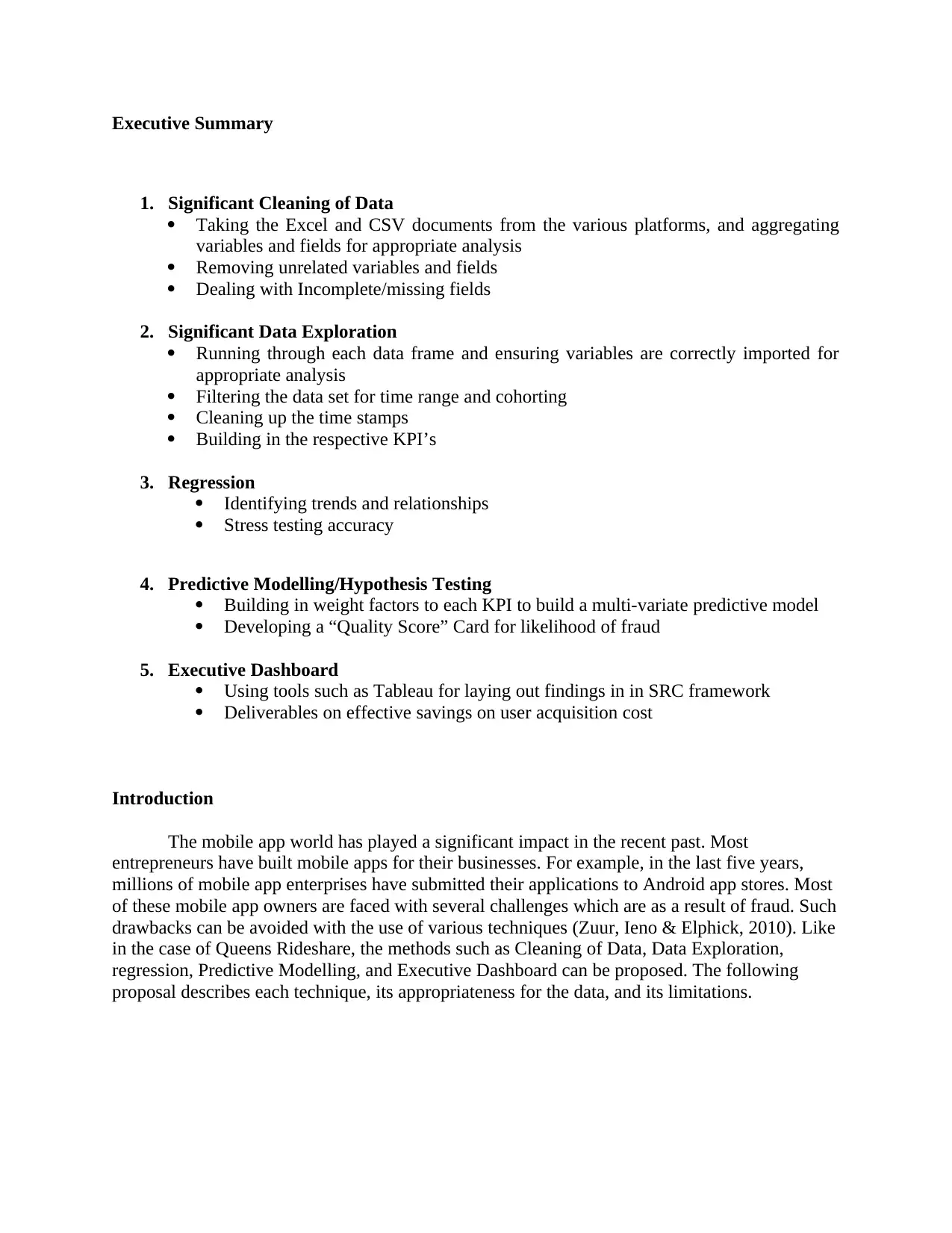
Executive Summary
1. Significant Cleaning of Data
Taking the Excel and CSV documents from the various platforms, and aggregating
variables and fields for appropriate analysis
Removing unrelated variables and fields
Dealing with Incomplete/missing fields
2. Significant Data Exploration
Running through each data frame and ensuring variables are correctly imported for
appropriate analysis
Filtering the data set for time range and cohorting
Cleaning up the time stamps
Building in the respective KPI’s
3. Regression
Identifying trends and relationships
Stress testing accuracy
4. Predictive Modelling/Hypothesis Testing
Building in weight factors to each KPI to build a multi-variate predictive model
Developing a “Quality Score” Card for likelihood of fraud
5. Executive Dashboard
Using tools such as Tableau for laying out findings in in SRC framework
Deliverables on effective savings on user acquisition cost
Introduction
The mobile app world has played a significant impact in the recent past. Most
entrepreneurs have built mobile apps for their businesses. For example, in the last five years,
millions of mobile app enterprises have submitted their applications to Android app stores. Most
of these mobile app owners are faced with several challenges which are as a result of fraud. Such
drawbacks can be avoided with the use of various techniques (Zuur, Ieno & Elphick, 2010). Like
in the case of Queens Rideshare, the methods such as Cleaning of Data, Data Exploration,
regression, Predictive Modelling, and Executive Dashboard can be proposed. The following
proposal describes each technique, its appropriateness for the data, and its limitations.
1. Significant Cleaning of Data
Taking the Excel and CSV documents from the various platforms, and aggregating
variables and fields for appropriate analysis
Removing unrelated variables and fields
Dealing with Incomplete/missing fields
2. Significant Data Exploration
Running through each data frame and ensuring variables are correctly imported for
appropriate analysis
Filtering the data set for time range and cohorting
Cleaning up the time stamps
Building in the respective KPI’s
3. Regression
Identifying trends and relationships
Stress testing accuracy
4. Predictive Modelling/Hypothesis Testing
Building in weight factors to each KPI to build a multi-variate predictive model
Developing a “Quality Score” Card for likelihood of fraud
5. Executive Dashboard
Using tools such as Tableau for laying out findings in in SRC framework
Deliverables on effective savings on user acquisition cost
Introduction
The mobile app world has played a significant impact in the recent past. Most
entrepreneurs have built mobile apps for their businesses. For example, in the last five years,
millions of mobile app enterprises have submitted their applications to Android app stores. Most
of these mobile app owners are faced with several challenges which are as a result of fraud. Such
drawbacks can be avoided with the use of various techniques (Zuur, Ieno & Elphick, 2010). Like
in the case of Queens Rideshare, the methods such as Cleaning of Data, Data Exploration,
regression, Predictive Modelling, and Executive Dashboard can be proposed. The following
proposal describes each technique, its appropriateness for the data, and its limitations.
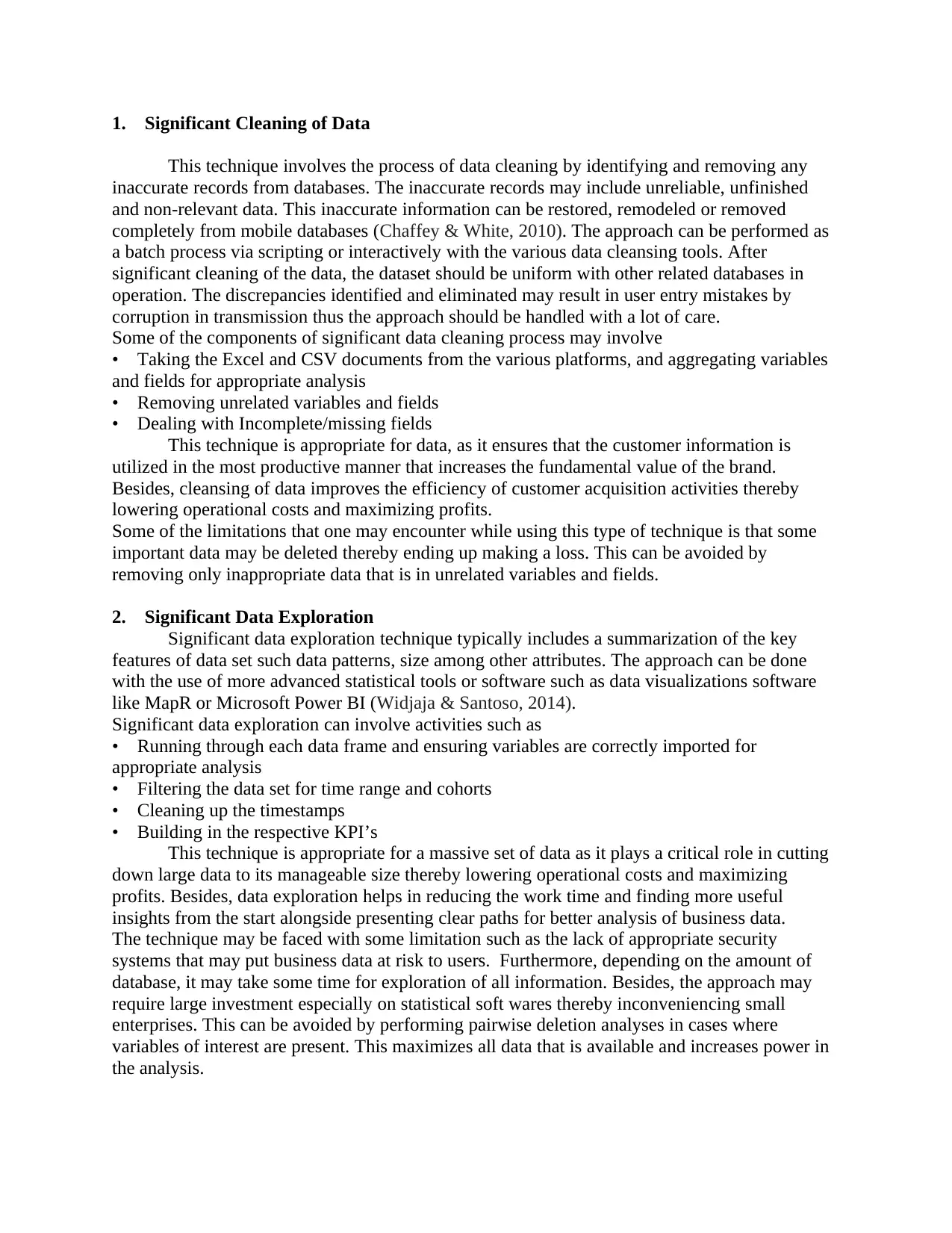
1. Significant Cleaning of Data
This technique involves the process of data cleaning by identifying and removing any
inaccurate records from databases. The inaccurate records may include unreliable, unfinished
and non-relevant data. This inaccurate information can be restored, remodeled or removed
completely from mobile databases (Chaffey & White, 2010). The approach can be performed as
a batch process via scripting or interactively with the various data cleansing tools. After
significant cleaning of the data, the dataset should be uniform with other related databases in
operation. The discrepancies identified and eliminated may result in user entry mistakes by
corruption in transmission thus the approach should be handled with a lot of care.
Some of the components of significant data cleaning process may involve
• Taking the Excel and CSV documents from the various platforms, and aggregating variables
and fields for appropriate analysis
• Removing unrelated variables and fields
• Dealing with Incomplete/missing fields
This technique is appropriate for data, as it ensures that the customer information is
utilized in the most productive manner that increases the fundamental value of the brand.
Besides, cleansing of data improves the efficiency of customer acquisition activities thereby
lowering operational costs and maximizing profits.
Some of the limitations that one may encounter while using this type of technique is that some
important data may be deleted thereby ending up making a loss. This can be avoided by
removing only inappropriate data that is in unrelated variables and fields.
2. Significant Data Exploration
Significant data exploration technique typically includes a summarization of the key
features of data set such data patterns, size among other attributes. The approach can be done
with the use of more advanced statistical tools or software such as data visualizations software
like MapR or Microsoft Power BI (Widjaja & Santoso, 2014).
Significant data exploration can involve activities such as
• Running through each data frame and ensuring variables are correctly imported for
appropriate analysis
• Filtering the data set for time range and cohorts
• Cleaning up the timestamps
• Building in the respective KPI’s
This technique is appropriate for a massive set of data as it plays a critical role in cutting
down large data to its manageable size thereby lowering operational costs and maximizing
profits. Besides, data exploration helps in reducing the work time and finding more useful
insights from the start alongside presenting clear paths for better analysis of business data.
The technique may be faced with some limitation such as the lack of appropriate security
systems that may put business data at risk to users. Furthermore, depending on the amount of
database, it may take some time for exploration of all information. Besides, the approach may
require large investment especially on statistical soft wares thereby inconveniencing small
enterprises. This can be avoided by performing pairwise deletion analyses in cases where
variables of interest are present. This maximizes all data that is available and increases power in
the analysis.
This technique involves the process of data cleaning by identifying and removing any
inaccurate records from databases. The inaccurate records may include unreliable, unfinished
and non-relevant data. This inaccurate information can be restored, remodeled or removed
completely from mobile databases (Chaffey & White, 2010). The approach can be performed as
a batch process via scripting or interactively with the various data cleansing tools. After
significant cleaning of the data, the dataset should be uniform with other related databases in
operation. The discrepancies identified and eliminated may result in user entry mistakes by
corruption in transmission thus the approach should be handled with a lot of care.
Some of the components of significant data cleaning process may involve
• Taking the Excel and CSV documents from the various platforms, and aggregating variables
and fields for appropriate analysis
• Removing unrelated variables and fields
• Dealing with Incomplete/missing fields
This technique is appropriate for data, as it ensures that the customer information is
utilized in the most productive manner that increases the fundamental value of the brand.
Besides, cleansing of data improves the efficiency of customer acquisition activities thereby
lowering operational costs and maximizing profits.
Some of the limitations that one may encounter while using this type of technique is that some
important data may be deleted thereby ending up making a loss. This can be avoided by
removing only inappropriate data that is in unrelated variables and fields.
2. Significant Data Exploration
Significant data exploration technique typically includes a summarization of the key
features of data set such data patterns, size among other attributes. The approach can be done
with the use of more advanced statistical tools or software such as data visualizations software
like MapR or Microsoft Power BI (Widjaja & Santoso, 2014).
Significant data exploration can involve activities such as
• Running through each data frame and ensuring variables are correctly imported for
appropriate analysis
• Filtering the data set for time range and cohorts
• Cleaning up the timestamps
• Building in the respective KPI’s
This technique is appropriate for a massive set of data as it plays a critical role in cutting
down large data to its manageable size thereby lowering operational costs and maximizing
profits. Besides, data exploration helps in reducing the work time and finding more useful
insights from the start alongside presenting clear paths for better analysis of business data.
The technique may be faced with some limitation such as the lack of appropriate security
systems that may put business data at risk to users. Furthermore, depending on the amount of
database, it may take some time for exploration of all information. Besides, the approach may
require large investment especially on statistical soft wares thereby inconveniencing small
enterprises. This can be avoided by performing pairwise deletion analyses in cases where
variables of interest are present. This maximizes all data that is available and increases power in
the analysis.
⊘ This is a preview!⊘
Do you want full access?
Subscribe today to unlock all pages.

Trusted by 1+ million students worldwide
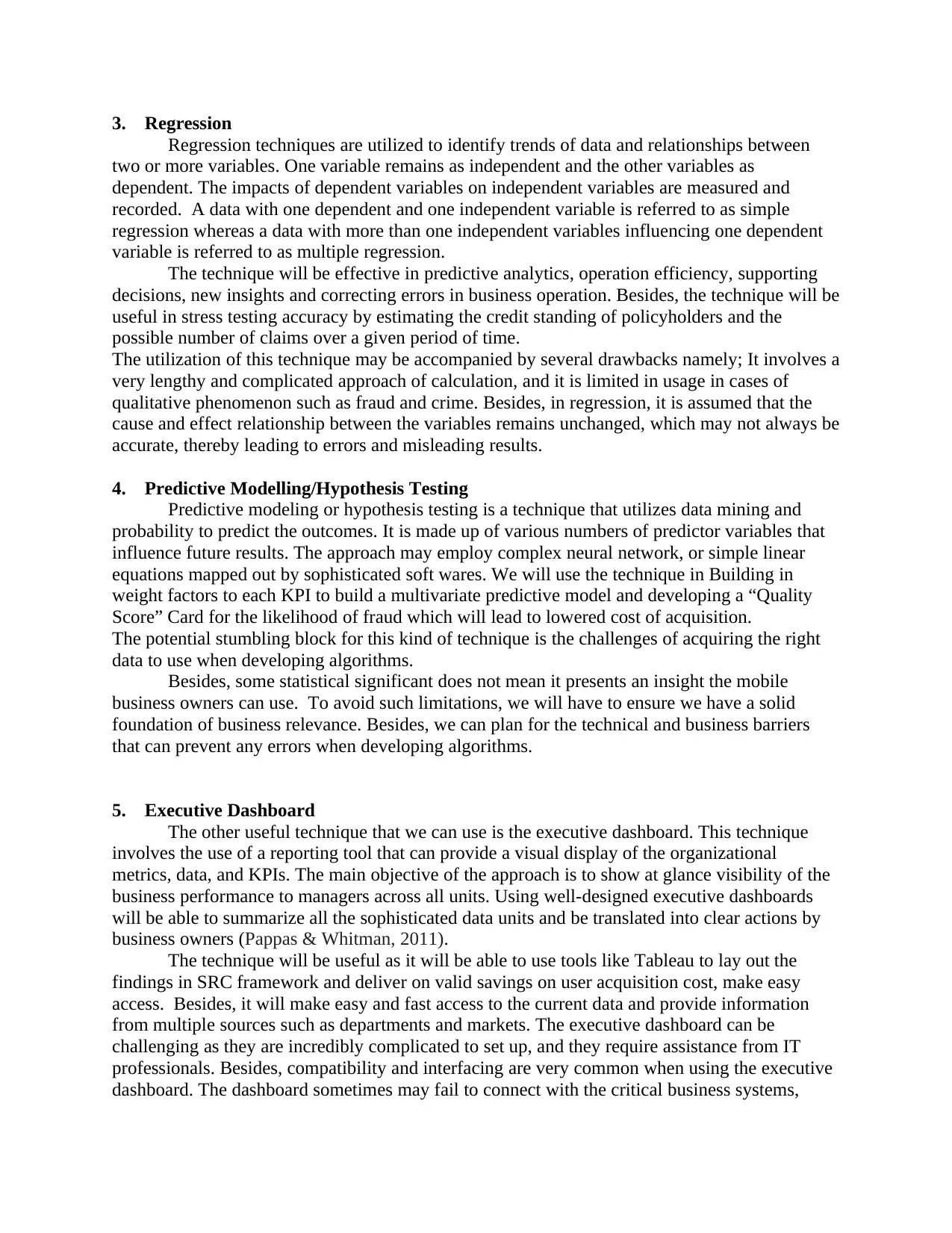
3. Regression
Regression techniques are utilized to identify trends of data and relationships between
two or more variables. One variable remains as independent and the other variables as
dependent. The impacts of dependent variables on independent variables are measured and
recorded. A data with one dependent and one independent variable is referred to as simple
regression whereas a data with more than one independent variables influencing one dependent
variable is referred to as multiple regression.
The technique will be effective in predictive analytics, operation efficiency, supporting
decisions, new insights and correcting errors in business operation. Besides, the technique will be
useful in stress testing accuracy by estimating the credit standing of policyholders and the
possible number of claims over a given period of time.
The utilization of this technique may be accompanied by several drawbacks namely; It involves a
very lengthy and complicated approach of calculation, and it is limited in usage in cases of
qualitative phenomenon such as fraud and crime. Besides, in regression, it is assumed that the
cause and effect relationship between the variables remains unchanged, which may not always be
accurate, thereby leading to errors and misleading results.
4. Predictive Modelling/Hypothesis Testing
Predictive modeling or hypothesis testing is a technique that utilizes data mining and
probability to predict the outcomes. It is made up of various numbers of predictor variables that
influence future results. The approach may employ complex neural network, or simple linear
equations mapped out by sophisticated soft wares. We will use the technique in Building in
weight factors to each KPI to build a multivariate predictive model and developing a “Quality
Score” Card for the likelihood of fraud which will lead to lowered cost of acquisition.
The potential stumbling block for this kind of technique is the challenges of acquiring the right
data to use when developing algorithms.
Besides, some statistical significant does not mean it presents an insight the mobile
business owners can use. To avoid such limitations, we will have to ensure we have a solid
foundation of business relevance. Besides, we can plan for the technical and business barriers
that can prevent any errors when developing algorithms.
5. Executive Dashboard
The other useful technique that we can use is the executive dashboard. This technique
involves the use of a reporting tool that can provide a visual display of the organizational
metrics, data, and KPIs. The main objective of the approach is to show at glance visibility of the
business performance to managers across all units. Using well-designed executive dashboards
will be able to summarize all the sophisticated data units and be translated into clear actions by
business owners (Pappas & Whitman, 2011).
The technique will be useful as it will be able to use tools like Tableau to lay out the
findings in SRC framework and deliver on valid savings on user acquisition cost, make easy
access. Besides, it will make easy and fast access to the current data and provide information
from multiple sources such as departments and markets. The executive dashboard can be
challenging as they are incredibly complicated to set up, and they require assistance from IT
professionals. Besides, compatibility and interfacing are very common when using the executive
dashboard. The dashboard sometimes may fail to connect with the critical business systems,
Regression techniques are utilized to identify trends of data and relationships between
two or more variables. One variable remains as independent and the other variables as
dependent. The impacts of dependent variables on independent variables are measured and
recorded. A data with one dependent and one independent variable is referred to as simple
regression whereas a data with more than one independent variables influencing one dependent
variable is referred to as multiple regression.
The technique will be effective in predictive analytics, operation efficiency, supporting
decisions, new insights and correcting errors in business operation. Besides, the technique will be
useful in stress testing accuracy by estimating the credit standing of policyholders and the
possible number of claims over a given period of time.
The utilization of this technique may be accompanied by several drawbacks namely; It involves a
very lengthy and complicated approach of calculation, and it is limited in usage in cases of
qualitative phenomenon such as fraud and crime. Besides, in regression, it is assumed that the
cause and effect relationship between the variables remains unchanged, which may not always be
accurate, thereby leading to errors and misleading results.
4. Predictive Modelling/Hypothesis Testing
Predictive modeling or hypothesis testing is a technique that utilizes data mining and
probability to predict the outcomes. It is made up of various numbers of predictor variables that
influence future results. The approach may employ complex neural network, or simple linear
equations mapped out by sophisticated soft wares. We will use the technique in Building in
weight factors to each KPI to build a multivariate predictive model and developing a “Quality
Score” Card for the likelihood of fraud which will lead to lowered cost of acquisition.
The potential stumbling block for this kind of technique is the challenges of acquiring the right
data to use when developing algorithms.
Besides, some statistical significant does not mean it presents an insight the mobile
business owners can use. To avoid such limitations, we will have to ensure we have a solid
foundation of business relevance. Besides, we can plan for the technical and business barriers
that can prevent any errors when developing algorithms.
5. Executive Dashboard
The other useful technique that we can use is the executive dashboard. This technique
involves the use of a reporting tool that can provide a visual display of the organizational
metrics, data, and KPIs. The main objective of the approach is to show at glance visibility of the
business performance to managers across all units. Using well-designed executive dashboards
will be able to summarize all the sophisticated data units and be translated into clear actions by
business owners (Pappas & Whitman, 2011).
The technique will be useful as it will be able to use tools like Tableau to lay out the
findings in SRC framework and deliver on valid savings on user acquisition cost, make easy
access. Besides, it will make easy and fast access to the current data and provide information
from multiple sources such as departments and markets. The executive dashboard can be
challenging as they are incredibly complicated to set up, and they require assistance from IT
professionals. Besides, compatibility and interfacing are very common when using the executive
dashboard. The dashboard sometimes may fail to connect with the critical business systems,
Paraphrase This Document
Need a fresh take? Get an instant paraphrase of this document with our AI Paraphraser
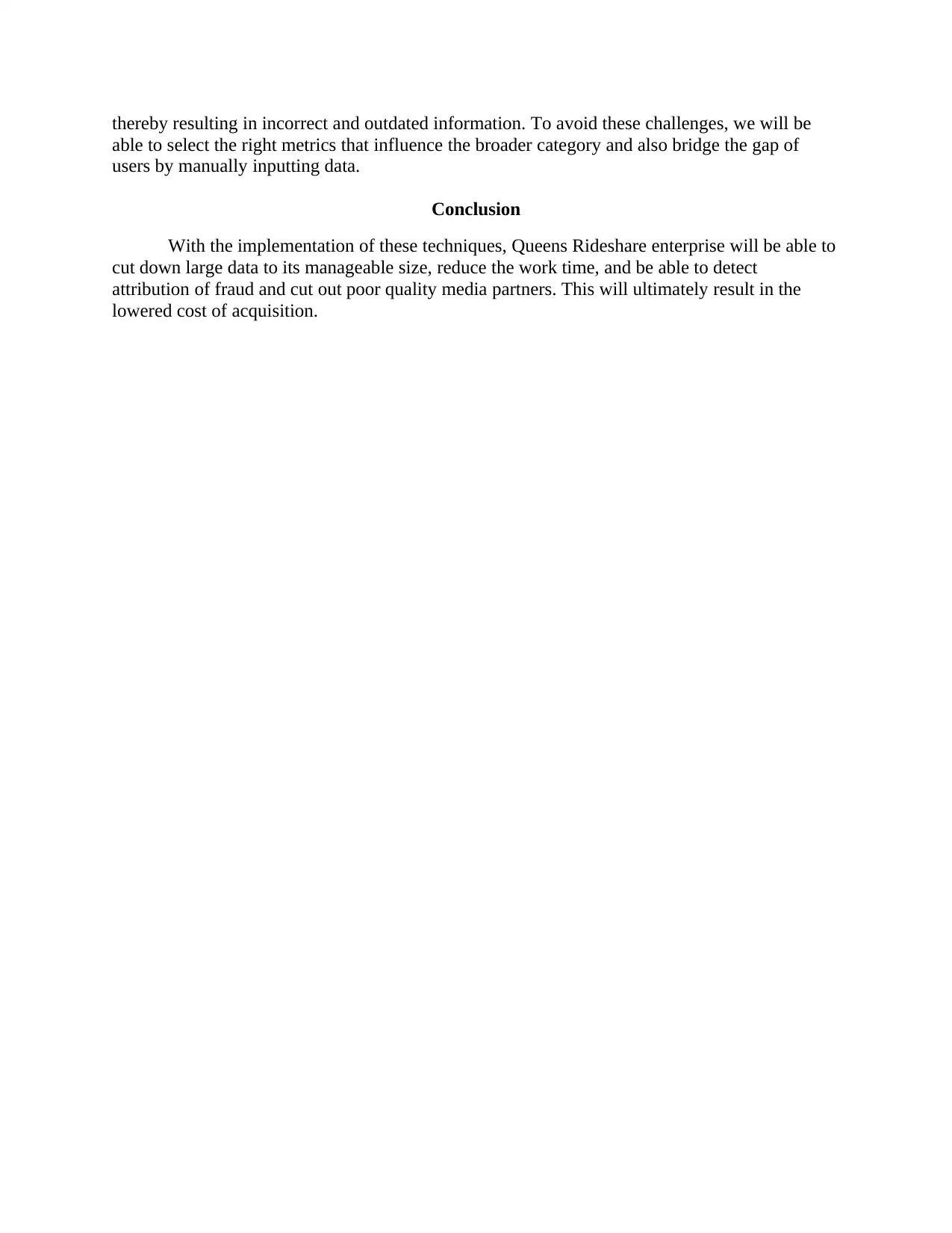
thereby resulting in incorrect and outdated information. To avoid these challenges, we will be
able to select the right metrics that influence the broader category and also bridge the gap of
users by manually inputting data.
Conclusion
With the implementation of these techniques, Queens Rideshare enterprise will be able to
cut down large data to its manageable size, reduce the work time, and be able to detect
attribution of fraud and cut out poor quality media partners. This will ultimately result in the
lowered cost of acquisition.
able to select the right metrics that influence the broader category and also bridge the gap of
users by manually inputting data.
Conclusion
With the implementation of these techniques, Queens Rideshare enterprise will be able to
cut down large data to its manageable size, reduce the work time, and be able to detect
attribution of fraud and cut out poor quality media partners. This will ultimately result in the
lowered cost of acquisition.
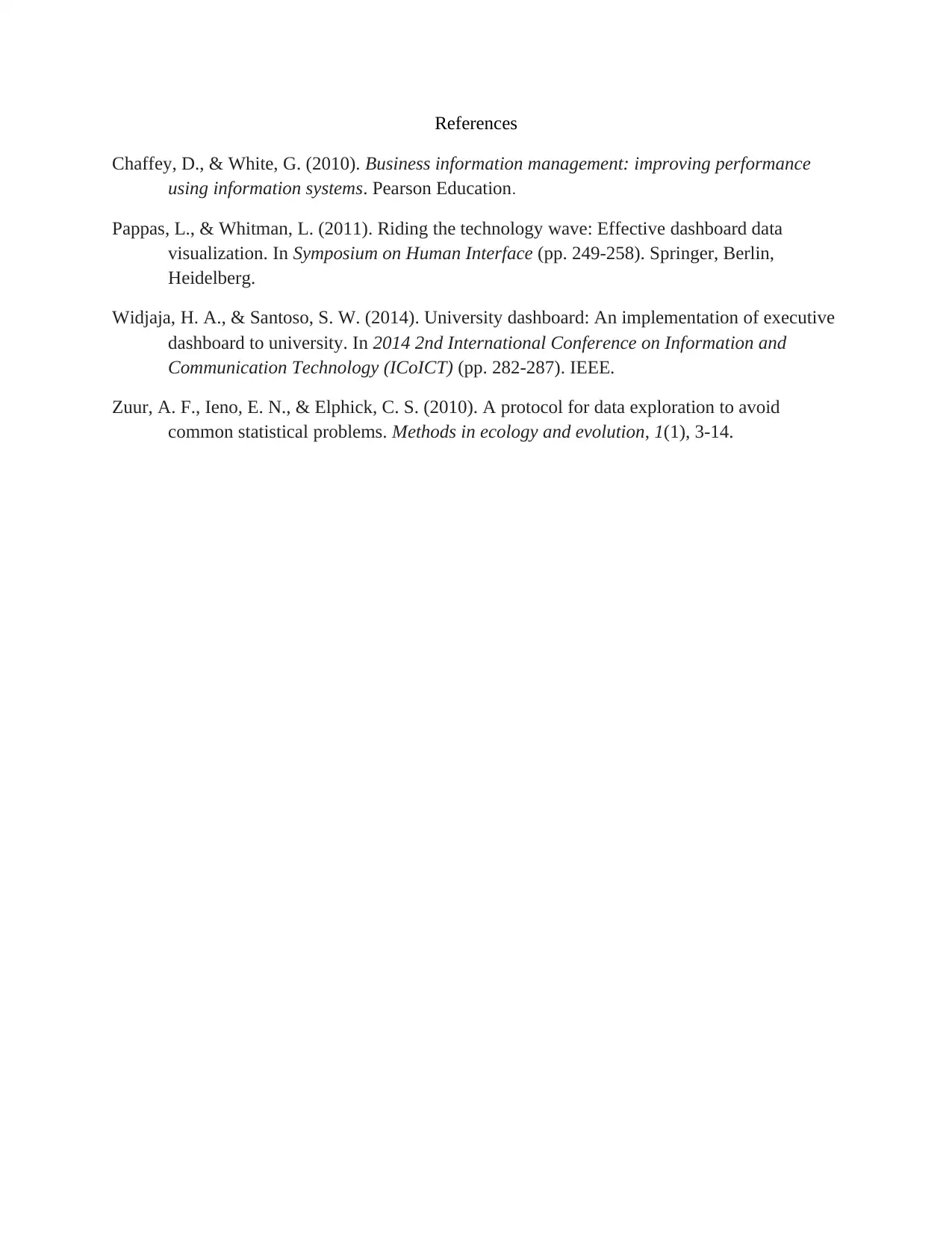
References
Chaffey, D., & White, G. (2010). Business information management: improving performance
using information systems. Pearson Education.
Pappas, L., & Whitman, L. (2011). Riding the technology wave: Effective dashboard data
visualization. In Symposium on Human Interface (pp. 249-258). Springer, Berlin,
Heidelberg.
Widjaja, H. A., & Santoso, S. W. (2014). University dashboard: An implementation of executive
dashboard to university. In 2014 2nd International Conference on Information and
Communication Technology (ICoICT) (pp. 282-287). IEEE.
Zuur, A. F., Ieno, E. N., & Elphick, C. S. (2010). A protocol for data exploration to avoid
common statistical problems. Methods in ecology and evolution, 1(1), 3-14.
Chaffey, D., & White, G. (2010). Business information management: improving performance
using information systems. Pearson Education.
Pappas, L., & Whitman, L. (2011). Riding the technology wave: Effective dashboard data
visualization. In Symposium on Human Interface (pp. 249-258). Springer, Berlin,
Heidelberg.
Widjaja, H. A., & Santoso, S. W. (2014). University dashboard: An implementation of executive
dashboard to university. In 2014 2nd International Conference on Information and
Communication Technology (ICoICT) (pp. 282-287). IEEE.
Zuur, A. F., Ieno, E. N., & Elphick, C. S. (2010). A protocol for data exploration to avoid
common statistical problems. Methods in ecology and evolution, 1(1), 3-14.
⊘ This is a preview!⊘
Do you want full access?
Subscribe today to unlock all pages.

Trusted by 1+ million students worldwide
1 out of 6
Your All-in-One AI-Powered Toolkit for Academic Success.
+13062052269
info@desklib.com
Available 24*7 on WhatsApp / Email
![[object Object]](/_next/static/media/star-bottom.7253800d.svg)
Unlock your academic potential
Copyright © 2020–2025 A2Z Services. All Rights Reserved. Developed and managed by ZUCOL.
